What are the four veils in Royal Arch Masonry? And what is the ‘Ceremony of Passing the Veils’? Although common throughout Scotland, Ireland and the United States, it is mostly unknown in England, presently only worked in the Province of Bristol. ( and by dispensation )

Fig. 31, Royal Arch Chapter. Duncan’s Masonic Ritual and Monitor, by Malcom C. Duncan, (1866)
At the destruction of Jerusalem by Nebuchadnezzar, three Most Excellent Masters were carried captives to Babylon, where they remained seventy years, and were liberated by Cyrus, King of Persia.
They returned to Jerusalem to assist in rebuilding the Temple, after travelling over rugged roads on foot.
They arrived at the outer veil of the Tabernacle, which was erected near the ruins of the Temple.
This Tabernacle was an oblong square, enclosed by four veils, or curtains, and divided into separate apartments by four cross veils, including the west end veil or entrance.
The veils were parted in the centre, and guarded by four guards, with drawn swords
A. Those of our ancient brethren, who directed and brought to light the principal secrets of this Degree, after they had lain buried in darkness from the death of our Grand Master Hiram Abiff, until the erection of the second temple, and as a reward for their zeal, fortitude and attachment to Masonry, were exalted to become the three Grand Masters of the veils.
Q. How many veils were they?
A. Four.
Q. What were their colors?
A. Blue, purple, scarlet and white.
Q. What does blue denote?
A. Friendship, and is the principal color of a Master Mason.
Q. What does purple denote?
A. It being composed of blue and scarlet, it is placed before the first and third veils of the colors, to denote the intimate connection between this most sublime degree, and ancient Craft Masonry.
Q. What does scarlet denote?
A. That fervency and zeal which should actuate all Royal Arch Masons, and is the peculiar color of this Degree.
Q. What does white denote?
A. That purity of life and rectitude of conduct which should govern all those who seek to gain admission into that Sanctum Sanctorum, or Holy of Holies.
Q. To whom do the four veils allude?
A. To the four tribes of the children of Israel, who bore the banners through the wilderness, viz.: Judah, Reuben, Ephraim and Dan, emblematically represented by the strength of the Lion, the intelligence of the Man, the patience of the Ox and the swiftness of the Eagle.
Q. Where were the veils placed?
A. At the outer courts of the tabernacle.
Source: Lecture on the Seventh, or Royal Arch Degree, Section First – Duncan’s Masonic Ritual and Monitor, by Malcom C. Duncan, (1866)
The Royal Arch Tabernacle, in its exterior, is similar to the Sinaitic Tabernacle, but in its interior it is different.
Within this Royal Arch Tabernacle are four veils, somewhat patterned after the decorations of Solomon’s Temple, but following more closely the legendary tabernacle of Zerubbabel.
As a whole, these four veils, constituting four divisions of the tabernacle, are symbolic of the obstacles in the way of advancement for the candidate in his search for the “lost word,” symbolic of Truth.
Passage through these veils represent triumph over these obstacles. Each of these veils is also symbolic, these symbolisms being indicated by the distinct colour of each one.
The Blue Veil is symbolic of universal friendship and benevolence, represented in the Symbolic Degrees through which the candidate has already passed.
The Purple Veil is symbolic of union, and represents the intimate connection between the Ancient Craft and Royal Arch Masonry.
The Scarlet Veil is a symbol of fervency and zeal, and is the distinct color of Royal Arch Masonry, indicating that only these qualities can the candidate be successful in his search for Truth.
The White Veil is a symbol of purity, and is a reminder to the candidate, who is now almost at the close of his search in Royal Arch Masonry, that it is only by purity of heart and life that he can hope to be successful in, or found worthy of the reception of Divine Truth.
Passage through each of these veils is also represented by significant Mosaic Signs, each of them deeply important in its symbolism.
Source: ‘Veils, Four in the Royal Arch Tabernacle’, Glossary, Phoenix Masonry.Org

When a significant constitutional development in English Royal Arch Masonry occurred in 1823, Master Masons were allowed to join Royal Arch Chapters without having previously passed through the chair of a Craft lodge.
In 1835, the ritual was reformed, when part of the ceremony known as ‘Passing the Veils’ was dropped.
It was re-adopted by Bristol Chapters at the turn of the 20th century.
The elaborate ceremony is essential to the Royal Arch Degree in the Irish system and after it is completed it is followed immediately by the Royal Arch degree itself, containing the story of the restoration of Solomon’s Temple under King Josiah.
The three presiding officers of a Royal Arch Chapter in Ireland are called the Excellent King, High Priest and Chief Scribe (not First, Second and Third Principal as in England and Wales).
The Sojourners and Scribes were replaced by the ‘Royal Arch Captain’, the ‘Captain of the Scarlet Veil’, the ‘Captain of the Purple Veil’ and the ‘Captain of the Blue Veil’.
Although not referred to as such in the ritual, the three principals are taken to be King Josiah, the High Priest Hilkiah and the scribe Shaphan.
Source: Holy Royal Arch Wikipedia
The ceremony of passing the veils, which formed part of the Royal Arch ceremony in the late 18th Century, probably had a Christian origin, and was customary only during the period when the RA. itself was largely a Christian degree.
With the de-Christianization of the degree following, firstly, the union of the Grand Chapters in 1817 and, secondly, the drastic revision in 1835, the ceremony of the veils rapidly disappeared from English Royal Arch Masonry. – Bernard E. Jones, Freemasons’ Book of the Royal Arch, 1957.
A ceremony of ‘Passing the Veils’ is common throughout Scotland, Ireland and the United States of America, although it may be part of a separate degree in some places, called either Excellent Master, Most Excellent Master, or Super Excellent Master.
It is, however, unknown in England except in the Province of Bristol, where it forms an integral part of the Exaltation ceremony. It is performed by every one of the twelve Chapters at every Exaltation ceremony and is the way by which the Companions, including the Candidate, gain entry to the Chapter room. – Antony Baker, AQC, Vol. 126, 2013.

‘The Complete Ceremony of Passing the Veils or E.M.
originally published by A. Lewis (Masonic Publishers, Fleet Street, London.)
Several papers explaining the history of the Ceremony of the Passing of Veils are available here:
The Real History of the Ceremony ‘Passing the Veils’ in Bristol by Bro. Antony R. Baker, from AQC Volume 126, 2013.
Passing the Veils: Ceremony and History by Excellent Companion Gordon Mogg.
https://usgcnsw.org.au/wp-content/uploads/2015/06/Disc_06_1503.pdf
The History of the Ceremony of the Passing of the Veils by Comp. Theodore-Eddie S. Kalogeropoulos https://cyprus-freemasons.org.cy/wp-content/uploads/2018/08/The-history-of-the-Ceremony-of-the-Passing-of-the-Veils.pdf
Recent Articles: Masonic Miscellanies
 Masonic Miscellanies - The Amulet of the Ladder Explore the cosmic significance of the Ladder in ancient Egyptian mythology through Wallis Budge's "Egyptian Magic." Discover how this profound symbol bridges the mortal and divine, encapsulating the Egyptians' fervent afterlife aspirations with a blend of myth, magic, and material culture. Dive into the celestial ascent of Osiris and mortal souls. |
 Masonic Miscellanies - Adulterine Gilds Guilds, the associations that shaped medieval European society, were more than just organizations of artisans and merchants. They played a vital role in the economic and social development of towns and cities. This exploration delves into the intriguing concept of adulterine gilds and their interconnectedness with guilds, offering insight into the significance of legal authorization and recognition in medieval Europe. |
 Masonic Miscellanies - Masonic Orb Discover the fascinating world of Masonic ball watch fobs, intricately crafted with tiny pyramids that form a cross when opened. These decorative accessories were all the rage in the late 1800s and early 1900s, and they still hold a certain allure today. Explore the different varieties and symbols found on these unique pieces that carry deep Masonic meaning. |
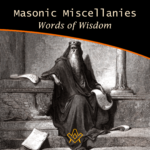 Masonic Miscellanies – Words of Wisdom Uncover timeless wisdom from King Solomon to Albert Pike in our latest Masonic Miscellanies, a treasure trove of insights for Masons. Journey through the ages and glean inspiring sayings, reflecting on their profound influence on Masonic principles. An enriching read for the enlightened. |
 Masonic Miscellanies - Symbolism of the Right Hand Unlock the enigmatic realm of Freemasonry as we delve into its age-old symbols, rituals, and philosophies. This thought-provoking exploration, drawn from Mackey's Revised Encyclopedia of Freemasonry, focuses on the iconic 'right hand' symbol - its rich history, universality, and profound significance. |
 Masonic Miscellanies - Order of the Secret Monitor Unveil the mystery of Freemasonry with 'The Order of the Secret Monitor'. Discover this lesser-known appendant order, its unique rituals, and the profound teachings it offers. Explore the bonds of friendship and brotherhood it fosters, all wrapped in an intriguing cloak of mystery. Your journey into the depths of Masonic wisdom begins here. |
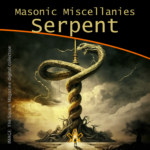 Masonic Miscellanies - The Symbol of the Serpent As a symbol, the serpent obtained a prominent place in all the ancient initiations and religions. |
 Masonic Miscellanies - The Four Veils in Royal Arch Masonry What are the four veils in Royal Arch Masonry? And what is the 'Ceremony of Passing the Veils'? Although common throughout Scotland, Ireland and the United States, it is mostly unknown in England, presently only worked in the Province of Bristol. ( and by dispensation ) |
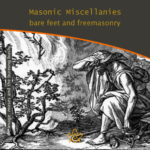 Masonic Miscellanies - Bare feet and Freemasonry A candidate for initiation into a Masonic Lodge often finds the requirements which he/she must fulfil somewhat odd. The mode of preparation often remains a puzzle, since the ritualistic explanation is not offered in full. Why are we 'slipshod' or "bare-footed" in Masonic Ritual? |
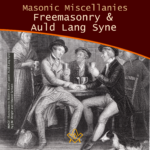 Masonic Miscellanies – Freemasonry and Auld Lang Syne Millions of people throughout the world will sing Auld Lang Syne to see out the Old Year. Few will know all the words, fewer still know what they mean, or that there is a link to Freemasonry. |
 Masonic Miscellanies - The Mosaic Pavement - why mosaic, why pavement? We are all familiar with the black and white chequered flooring of the Masonic lodge but where did it originate? There are a few theories… |
 Masonic Miscellanies – Masonic Master's Carpets Have you got a magic "Masonic Master's Carpet" in your lodge? I say 'magic' with my tongue firmly in my cheek because (as far as I know) these fabulous works of art don't bestow any mystical powers but can bestow some educational ones! However, considering their possible value today, they may magic up some interest (or funds). |
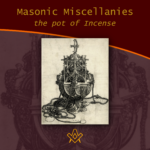 Masonic Miscellanies – The Pot of Incense Just when the pot of incense became an emblem of the third section of the Sublime Degree can not be stated with certainty. It is, apparently, an American invention or addition. But what does it symbolise? |
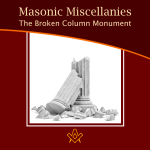 Masonic Miscellanies - The Broken Column Monument The story of the broken column was first illustrated by Amos Doolittle in the "True Masonic Chart" by Jeremy Cross, published in 1819. |
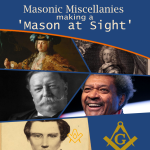 Masonic Miscellanies - Making a 'Mason at Sight' What does it mean to make a 'Mason at sight', and who was made one? |
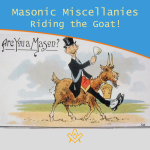 Masonic Miscellanies - Riding the Goat! Many Freemasons will have come across the phrase 'riding the goat', and will no doubt have been the butt of a joke about it (sorry, I couldn't resist!) But what does it mean and where did the phrase come from? |
 Masonic Miscellanies - What are the 'three dots'? Three dots or points in an upright triangular shape ∴ is most commonly known as the 'therefore' sign – so why is it used in Freemasonry? |
 Masonic Miscellanies - Keep Within Compass This month we discover a series of allegorical prints warning us to "Keep within Compass and you shall be sure, to avoid many troubles which others endure." |
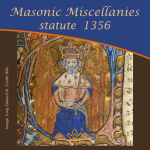 Masonic Miscellanies - statute 1356 Further to the reference in the article – The Builders - 6 - Free-Masons 'a statute was enacted against the Free-masons in 1356' – Regulations for masons who are hewers, on the one hand, and the light masons and setters on the other. |
 Masonic Miscellanies - An Anti-Masonic 'Apron'? The Anti-Masonic 'Apron' was created during the 1832 Presidential election in USA. It was not Ani-masonic. And it was not an apron. Read on to find out what and why it was created. |
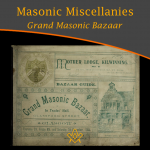 Masonic Miscellanies - Grand Masonic Bazaar (1895) Grand Masonic Bazaar (1895); to raise funds to clear the debt incurred by “Mother Kilwinning” in rebuilding their Lodge. |
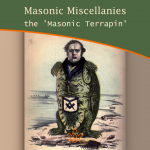 Masonic Miscellanies - the 'Masonic Terrapin' A satirical book from 1851 includes a bizarre caricature of a 'Masonic Terrapin' - all I can say is 'read on'… |
 Masonic Miscellanies - Masonic Bookplates You probably know what a bookplate is for, but did you know that the earliest known book mark/label dates from the reign of Amenhotep III in Egypt around 1391−1353 BCE?! |
 Masonic Miscellanies - Freemasonry & Bees Freemasonry & Bees - what's the buzz? The bee was among the Egyptians the symbol of an obedient people, because, says Horapollo, of all insects, the bee alone had a king. |
 Masonic Miscellanies - The mystery of the Tattooed Freemason In 1894, the body of a drowned man was found in the Bay of San Francisco - what they discovered was amazing. |
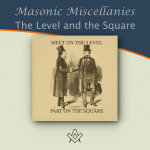 Masonic Miscellanies - The Level and the Square (A Poem) The Level and the Square (A Poem) - "We meet upon the Level, and we part upon the Square – |
 Masonic Miscellanies - The Mystic Tie What is the 'Mystic Tie'? Clue: it's not an item of neckwear! |
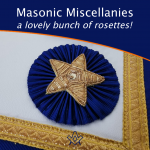 Masonic Miscellanies - A lovely bunch of rosettes! Where did the origin of the use of rosettes on Masonic aprons come from ? |
 Masonic Miscellanies - The Lodge of Sorrow The Lodge of Sorrow - Extracted General Ahiman Rezon, by Daniel Sickles, [1868] |
 Masonic Miscellanies - Memento Mori Memento Mori - a Masonic reminder to make your mark on the world |
 Masonic Miscellanies - A closer look at the Level and the Plumb-rule A closer look at the Level and the Plumb-rule |
 Masonic Miscellanies - The Symbolism of the Gloves The Symbolism of the Gloves and why Freemasons wear white gloves |
 Masonic Miscellanies - Will the real James Anderson please stand up? Will the real James Anderson please stand up? |
 Masonic Miscellanies - The Legend of the Third Degree The most important and significant of the legendary symbols of Freemasonry is, undoubtedly, that which relates to the fate of Hiram Abif. |
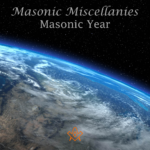 Masonic Miscellanies - Masonic Calendar Why do Freemasons use different 'years' to our regular calendar? |
 Masonic Miscellanies - What is a 'Lewis'? The English word 'Lewis' is a term belonging to operative Masonry, and signifies an iron cramp, which is inserted in a cavity prepared for the purpose in a large stone. |
 Masonic Miscellanies - From J.S.M. Ward Ever wondered why masons had to be 'free' or why we have a Tyler? |
masonic knowledge
to be a better citizen of the world
share the square with two brothers

click image to open email app on mobile device








